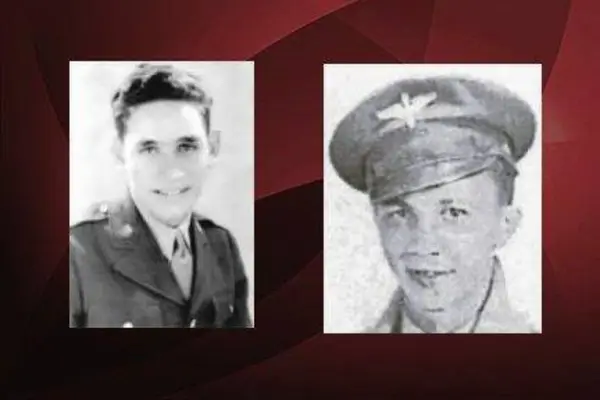Two Westmoreland County airmen who survived the loss of their B-29 bombers during separate World War II missions over Japan were among POWs who perished 80 years ago when the military prison where they were being held was destroyed during an American firebombing raid on Tokyo.
The stories and sacrifices of Vandergrift native Thomas Louis Klingensmith and John William “Jack” Meagher of Ligonier have been memorialized as part of Stories Behind the Stars, an online nonprofit project developed to honor America’s World War II fallen service members.
The Tokyo Military Prison was consumed by fire during the night of May 25-26, 1945, as more than 460 B-29 Superfortress heavy bombers flew from a base on the Marianas Islands to drop incendiary bombs on Japan’s capital city. At least 62 Americans are believed to have died in the prison blaze.
According to Stories Behind the Stars, the prison’s guards locked the cell doors to block escape from the fire while POWs who did attempt to escape were executed. The guards were convicted at a later war crimes tribunal and were executed.
The May 25 mission was the fifth and final U.S. low-altitude nighttime incendiary raid on areas of Tokyo, Richard Sams notes in a May 25, 2015, article in The Asia-Pacific Journal.
During the first of the raids, on March 10, 1945, 279 B-29s dropped 1,665 tons of incendiaries, scorching nearly 16 square miles, killing more than 100,000 people and leaving more than a million more homeless.
Over the night of May 25-26, U.S. bombers dropped 3,258 tons of incendiaries in the heart of Tokyo. The toll was 3,242 people killed, more than 559,000 others left homeless and almost 17 square miles incinerated.
During the series of bombing raids, a total of nearly 57 square miles of Tokyo was destroyed.
Born Aug, 11, 1924, in Atlasburg, Washington County, Meagher moved with his family in the 1930s to Ligonier. There his father, also John W., became a crew foreman at the coal works for the Bethlen Home for orphans and the elderly.
Meagher and a younger sister spent two years at Cresson Sanatorium recuperating from tuberculosis. He was known as an accomplished ice skater while attending high school in Ligonier.
He was working as a stock boy at a local store when he was drafted into the Army in April 1943.
He entered air cadet training at the University of Pittsburgh, but scarlet fever forced his reassignment to gunnery school. He qualified as a tail gunner on a B-29 and reported for duty in the Marianas on Jan. 2, 1945.
Klingensmith was born worked as a grocery clerk and truck driver.
He graduated from New Kensington High School in 1936, married Winifred McGlynn on June 30, 1938, and found work with the American Window Glass Co. in Arnold.
He enlisted in the Army Air Forces at Greensburg on
Oct. 26, 1943, and entered active duty Nov. 16.
Klingensmith attained the rank of sergeant. He and his squadron were deployed in February 1945 to Guam, where they joined the 314th Bomb Wing.
Meagher was the first to fall behind enemy lines, during a bombing run to Tokyo on April 7, 1945. His crew’s plane was hit by a phosphorous bomb, possibly dropped by another aircraft flying higher in the formation.
Meagher’s crew managed to drop its bombs shortly before the B-29 lost a wing and exploded, killing eight of the airmen on board. Meagher and three others parachuted to the ground but were captured as POWs.
Five of about 100 B-29 bombers, including Klingensmith’s, were lost on April 24, 1945, during a mission to bomb an Hitachi aircraft factory at Tachikawa — in the western part of the Tokyo metropolitan area.
Klingensmith and 10 crew mates were taken prisoner when their bomber was shot down by enemy aircraft and anti-aircraft artillery and crashed near the target.
Klingensmith, whose remains were unrecoverable, was posthumously awarded the Air Medal and Purple Heart. He was memorialized on the Tablets of the Missing at the National Memorial Cemetery of the Pacific in Honolulu.
Meagher’s remains were recovered and, after being identified, were moved from an Air Force cemetery in Yokohama for final burial on
Oct. 6, 1949, at Arlington
National Cemetery.
Featured Local Businesses


AloJapan.com